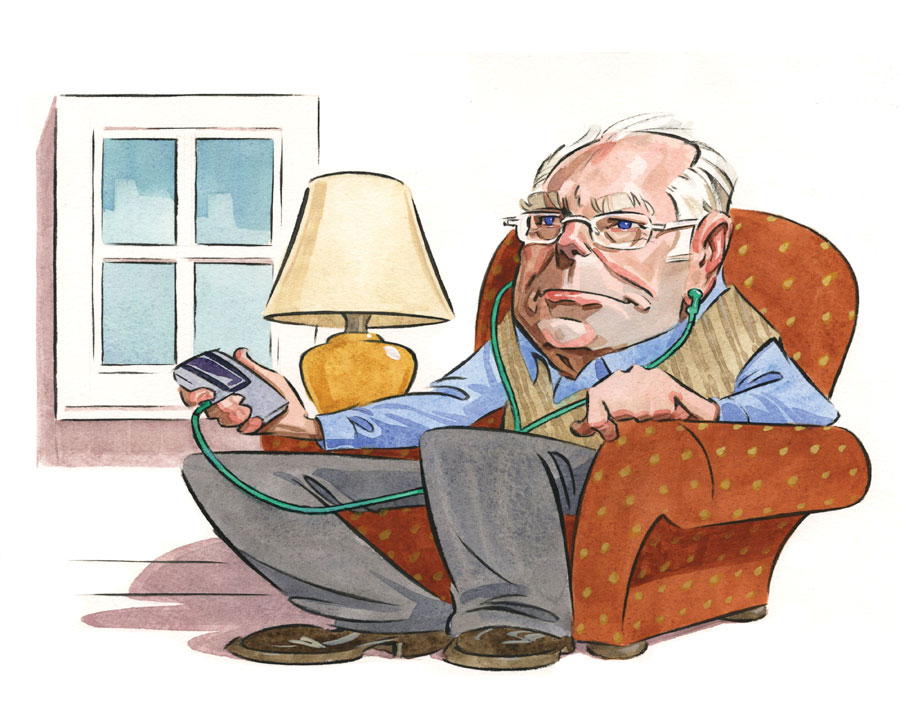
Several years ago, doctors told contractor Michael Brown that the herniated disc responsible for his chronic lower back pain could only be fixed with surgery. Wanting to delay that option for as long as possible, he relied on a combination of oral steroids, muscle relaxers, and the occasional spinal epidural to treat his pain. Nothing kept it at bay for long, until he tried the Alpha-Stim M device last May. “I haven’t had any flare-ups or had to use any steroids or muscle relaxers since I started using the Alpha-Stim,” says Brown.
Cranial electrotherapy stimulation (CES) is an FDA-approved technique that uses low-level electrical currents to treat conditions ranging from insomnia, anxiety, and depression to chronic pain and PTSD. The largest manufacturer of CES devices, Texas-based Electromedical Products International, Inc., released the first Alpha-Stim device in 1981. The Alpha-Stim AID model (a handheld, iPod-shaped device that retails for around $800) is used exclusively for mental health indications through the use of earclips; the slightly larger (and full 50 percent pricier) M model has all the capabilities of the AID model plus the ability to treat pain with the use of probes or attachable electrodes.
The largest consumer of Alpha-Stim devices is the Department of Veterans Affairs, which has been using them to treat anxiety, PTSD, insomnia, depression, pain, and headaches in soldiers since the early 2000s, when they discovered the technology’s effectiveness in reducing active-duty soldiers’ symptoms without the dangerous side effects that accompany use of medications. In recent years, the VA has been using Alpha-Stim as part of its ongoing effort to decrease reliance on opioids in treating veterans suffering from chronic pain and PTSD.
Saint Therese Senior Living Community in New Hope recently piloted the device on eight residents living with dementia-related insomnia over five weeks and found that they got, on average, 43 more minutes of sleep each night and 120 minutes less of WASO (wake after sleep onset)—a significant improvement in both the quantity and quality of sleep. The pilot program was such a success that Alpha-Stim will be rolled out to 22 more long-term care facilities across Minnesota this spring.

The safety and lack of side effects associated with Alpha-Stim make it a favorite tool of Dr. Tim Culbert, a developmental and behavioral pediatrician with Prairie Care Medical Group, who uses it to treat anxiety, insomnia, and chronic pain in his young patients. “It’s very safe and very effective,” says Dr. Culbert. “It’s a passive technology, so kids can have it on their ears before school while reading a book, watching TV, or eating breakfast. I call it the lazy person’s meditation.”
Like meditation, Alpha-Stim has been shown to increase alpha brain waves, which are associated with relaxation and a sense of wakeful rest. In a 2014 clinical trial, 83 percent of participants reported a 50 percent or greater reduction in anxiety after five weeks of daily Alpha-Stim treatments.
In June 2014, the FDA authorized a change in classification of the Alpha-Stim from a class III to a class II device, which will make it available to individuals without a prescription. But the FDA moves slowly, and it remains unclear when the change will go into effect. For now, the only authorized Alpha-Stim distributor in Minnesota is Begin Healing, a family-owned company based in Grand Rapids, which offers the device to individuals with a prescription from anyone licensed to diagnose any of the conditions for which it’s indicated (insomnia, pain, anxiety, and depression) and healthcare practitioners across the state.
With the change in classification and increasing interest in alternatives to medication, Alpha-Stim’s popularity is likely to grow. “Billions of dollars are being spent on complementary and integrative therapies, natural, holistic, and non-pharmacological options for insomnia, pain, autism, ADD, and anxiety,” says Dr. Culbert. “When you balance safety and efficacy, I’d rather try this with most kids than put them on Prozac or Zoloft.”
